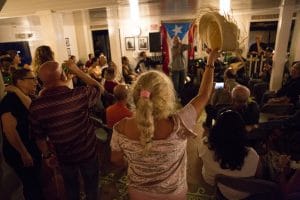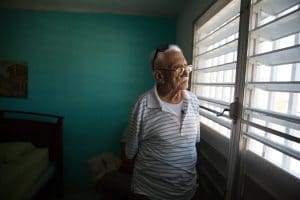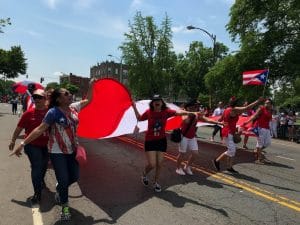One year ago this month, Hurricane Maria made landfall in Puerto Rico. Through The Island Next Door, an ongoing, multi-platform reporting initiative, Connecticut Public Radio has remained committed to telling the stories of real people touched by the storm, both on and off the island. The Island Next Door: Puerto Rico and Connecticut After Hurricane Maria features a collection of these stories.
The documentary premiered on September 20, 2018 on CPTV. It is now available to stream on demand here at CPTV Passport and at theislandnextdoor.wnpr.org.

Attendees find respite amid recovery efforts at free concerts at La Casa Histórica de la Música Cayeyana. Photo by Ryan Caron King
We sat down with Connecticut Public Radio’s News Director Jeff Cohen and Visual and Radio Reporter Ryan Caron King to discuss their most recent trip to Puerto Rico, what they’ve learned over the past year, and why the story of Hurricane Maria is a local one.
You’ve just returned from your third trip to the island since the storm hit almost one year ago. Can you give us an update about current recovery efforts?
Jeff Cohen: Most people have power, though some still don’t; those that do say they often lose it, or it’s irregular at best. The things we saw on our first trip — downed power lines and poles, mudslides, the stuff of hurricane disasters — have largely been cleaned up.
Perhaps harder to see but just as important is the emotional trauma that those on the island are still dealing with. Minor rainstorms can become major emotional events, as residents say they fear losing what they have spent the past year trying to recover.

Alejandro La Luz Rivera insisted on returning to Puerto Rico last year after the hurricane because he didn’t want to leave the home he and his wife
built together. Photo by Ryan Caron King
Over a year of reporting, which story/stories have impacted you the most?
JC: Each story is unique, many are deeply personal, and all of them are snapshots in time of a place and its people. What we often found most gripping were the stories of people who were figuring out their own personal paths of recovery. These aren’t simply stories about Puerto Rico and Puerto Ricans; they’re stories about people.
Ryan Caron King: We spent time earlier this year telling the stories of hurricane evacuees trying to make it work in Connecticut after losing their homes on the island. Many were living in uncertainty for months, having a hard time finding a permanent place to live and not knowing when their FEMA assistance would run out.
A powerful moment came in June at the Puerto Rican Day Parade in Hartford. A group of hurricane evacuees lead the parade carrying a giant Puerto Rican flag as they celebrated their island after months of hardship that came with making a new life in an unfamiliar place.

Hurricane evacuees in Hartford led the way during the city’s Puerto Rican Day Parade in June 2018. Photo by Frankie Graziano
Why is the story of recovery efforts in Puerto Rico important as it relates to the state of Connecticut?
JC: Connecticut had hundreds of thousands of residents with Puerto Rican roots before the hurricane. Thousands more came after Maria hit. For us to treat the storm and its aftermath as anything other than a local story would be to fail in our work and our public service mission.
The Island Next Door: Puerto Rico and Connecticut After Hurricane Maria premiered Thursday, September 20, 2018 on CPTV. It is now available to stream online on this page, at CPTV Passport and at theislandnextdoor.wnpr.org.
Funding provided by Duracell’s PowerForward Program and UConn Health
Some music used in this program was used under Creative Commons licenses, including:
“The Idea of Space” by Lee Rosevere, licensed under CC BY-NC 4.0
“Taking the Time” by Lee Rosevere, licensed under CC BY-NC 4.0
“Willow Belle” by Blue Dot Sessions, licensed under CC BY-NC 4.0
“La Focsa” by Blue Dot Sessions, licensed under CC BY-NC 4.0
“The Oceans Continue to Rise” by Chris Zabriskie, licensed under CC BY 4.0
